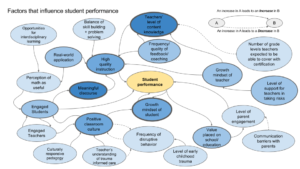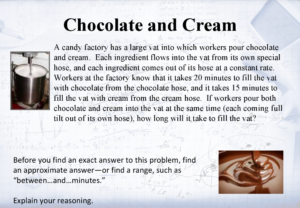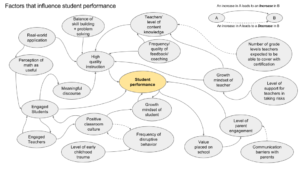At the end of March, we met with a group of group of students from Reagan High School who were working in or looking for internships in STEM fields. We heard three key concerns:
- Students want a chance to exercise the skills they’ve been developing
- Students want the internship to be a chance to learn
- Outside a few narrow fields, STEM internship opportunities for high school students are difficult to find
If students don’t get a chance to grow and learn, an internship is “just a job”, and those take a lot less effort to find.
In our May session we’ll dig in to the opportunities for, and barriers to, creating effective STEM internships for high school students– what it takes to create internship experiences that students value, how we raise the visibility/number of internships available in a broader range of STEM fields, and what does it look like when the goal of an internship program is talent development rather than simply low cost labor.
Come share ideas with your colleagues at public, private, and charter schools from across greater Milwaukee, as well as some folks outside of K12 who offer an interesting perspective on the topic.
Agenda
5:30 – 6:00 Grab something to eat and drink, say hello
6:00 – 8:30 Let’s learn from each other.
Food and beverage will be provided. There is no charge for participation but space is limited!
Featured Participants
Among others, you’ll have a chance to talk with:
Tamera Coleman– Internship Coordinator, Milwaukee Public Schools
Tamera is responsible for the development and implementation of a viable internship program at the district level. Tamera spends time facilitating student learning by assisting students to secure appropriate internships to enhance overall academic experience while learning essential skills. Tamera also initiates and builds partnerships with employers to develop student opportunities for endeavors locally. Tamera is also a proud MPS alumni, a mother of 2 young children, a wife of an educator and a Milwaukee native truly committed to youth empowerment.
Matthew Hunt– College & Career Readiness Specialist, New Berlin High School
Matt previously worked as an Account Manager in the Professional Services Division of Aerotek, the largest staffing firm in the country, where he worked with businesses across multiple industries to help them find talent in Accounting/Finance, Supply Chain, Marketing, Customer Service, and Administrative Support. He later served as a School Counselor at New Berlin West for 3 years and took a leadership role with the district’s Career and Service Based Learning Program. During the 2017-18 school year, Matt transitioned into a newly created role as the District’s College and Career Readiness Specialist and now manages Youth Apprenticeship and Internship programs at both New Berlin West and New Berlin Eisenhower high schools.
Ariana Radowicz– University Relations, Rockwell Automation
Ariana leads recruitment for Rockwell Automation’s high school internship programs as well as their scholarship/specialty programs. She also participates in ADVANCE, the company’s young professionals employee resource group and works to build a diverse pipeline of students for Rockwell’s early career programs.
Molly Schuld– Science Teacher, Ronald Reagan High School
Molly is a science teacher and a personal & professional skills teacher at Ronald Reagan High School. She came to Milwaukee through Teach For America and has now been teaching in Milwaukee Public Schools for four years. She holds a Bachelor of Science in Marine and Atmospheric Science and a Master of Education in Educational Policy and Leadership.
Molly also serves as the Ronald Reagan High School’s NAF Director for the Academy of Health Sciences, which involves connecting students to career-based learning experiences in the community. She secures STEM internship opportunities for Reagan’s upperclassmen in Milwaukee-area. Molly has also developed and continues to lead several programs including Reagan’s International Travel Program, SMART Team, and Girls In Technology Program.
Laura Schmidt, Strategic Advisor to the Superintendent – School District of New Berlin
Laura has an MBA (Leadership Studies) from Marquette University. She worked for 15 years for Northwestern Mutual and was responsible for enterprise software, usability testing, and technology research. She served as the Executive Director of an Education Foundation for 4 years before joining the School District of New Berlin as a consultant. She represents the Superintendent in local, regional and state efforts designed to support a strong talent pipeline for the benefit of students as well as the state’s economy. She holds a Scaled Agilist certification to inform strategic planning and implementation efforts.
Erica Steele– Manager, Workforce Development, Froedtert Health
Erica Steele is the Manager of Workforce Development at Froedtert Health focused on driving innovative workforce strategies internally and externally to grow and diversify the healthcare talent pipeline to meet current and future industry needs. This includes collaborating and partnering with educational institutions, workforce agencies, community based organizations, internal stakeholders, and others to identify, engage, train and create pathways for talent to enter and advance in the healthcare field. She provides subject matter expertise on the topics of workforce development, education/training, program development and management, volunteer management, public speaking and fund development.

 At this session, we used a version of the Lean Startup Canvas to guide our thinking and capture our assumptions about the goals for the project, and how it might be structured. We started the process with a discussion of the problems we are trying to address through the project, and then stepped through the remaining sections of the canvas. We closed with a discussion around the importance of starting with validation of the key assumption– that the problems we identified matter to the students engaged in the project. The end result is available here:
At this session, we used a version of the Lean Startup Canvas to guide our thinking and capture our assumptions about the goals for the project, and how it might be structured. We started the process with a discussion of the problems we are trying to address through the project, and then stepped through the remaining sections of the canvas. We closed with a discussion around the importance of starting with validation of the key assumption– that the problems we identified matter to the students engaged in the project. The end result is available here: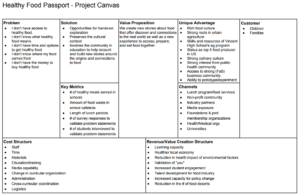
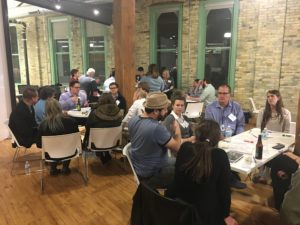 During Collab Lab 16, we walked participants through our model and had them beat up the idea in both small group discussions and a sharing out of key points to all participants.
During Collab Lab 16, we walked participants through our model and had them beat up the idea in both small group discussions and a sharing out of key points to all participants.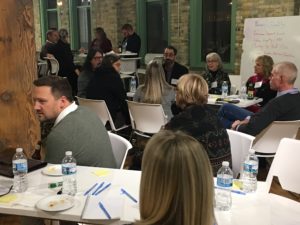 We thought we’d try and find some. Last night we pulled educators from across the area together with healthcare researchers and professionals. We asked Brian King, a Collab Lab regular and former Director of Innovation for the Milwaukee Jewish Day School to facilitate. Brian’s work with students to develop and launch student run projects with a social purpose help make him the right person to guide the group through what we wanted to accomplish. In short, to generate ideas for projects that:
We thought we’d try and find some. Last night we pulled educators from across the area together with healthcare researchers and professionals. We asked Brian King, a Collab Lab regular and former Director of Innovation for the Milwaukee Jewish Day School to facilitate. Brian’s work with students to develop and launch student run projects with a social purpose help make him the right person to guide the group through what we wanted to accomplish. In short, to generate ideas for projects that: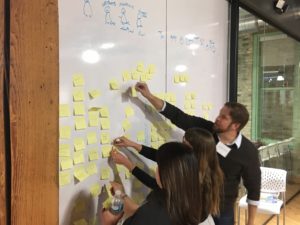 Participants started the evening with some Post-It Note brainstorming on the top five health related issues faced by school-age children. Three volunteers grouped these by topic. We talked through each cluster, did a bit of rearranging and pulled out our blue dots for a vote on which topics were most important.
Participants started the evening with some Post-It Note brainstorming on the top five health related issues faced by school-age children. Three volunteers grouped these by topic. We talked through each cluster, did a bit of rearranging and pulled out our blue dots for a vote on which topics were most important.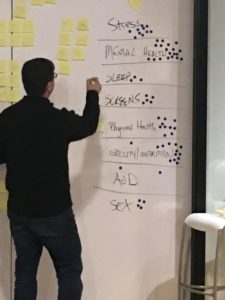
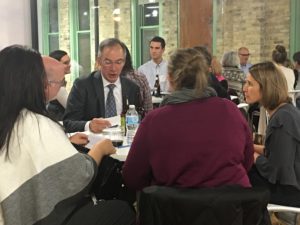 For this session, we split the attendees across 5 tables, where each participant shared their thoughts on key goals, and came together as a team to share those the felt were most important with the entire group. These included:
For this session, we split the attendees across 5 tables, where each participant shared their thoughts on key goals, and came together as a team to share those the felt were most important with the entire group. These included: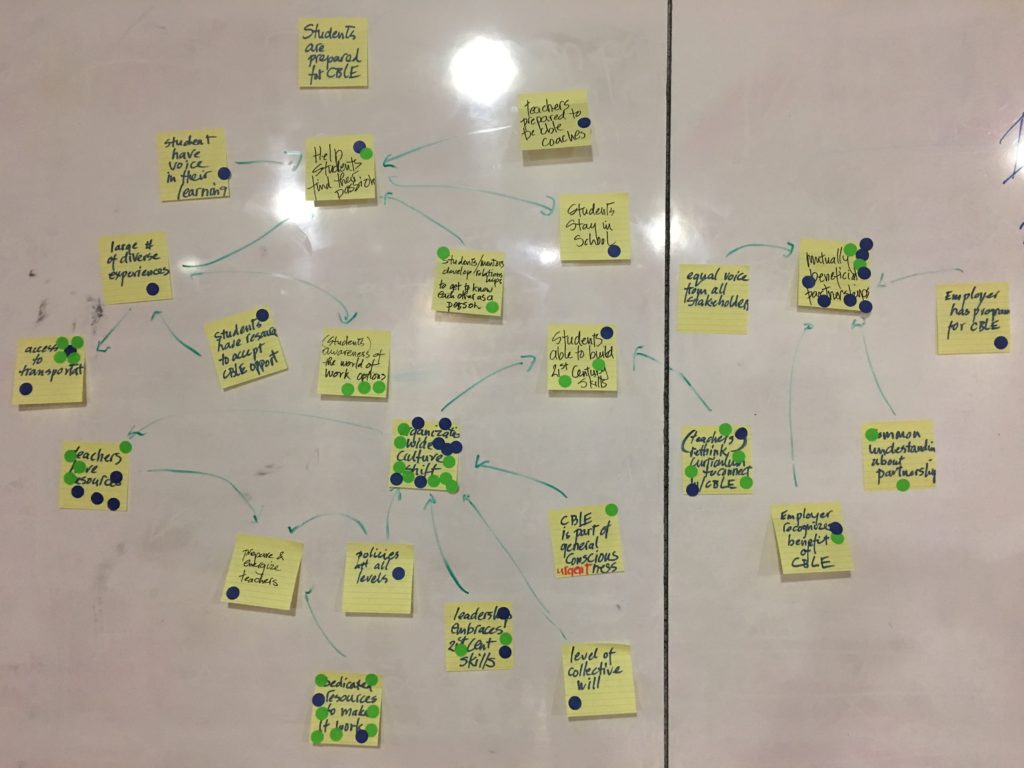
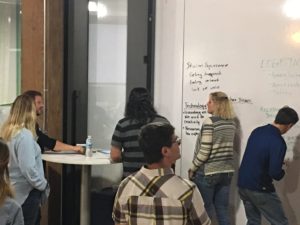 Bring King joined us for Collab Lab 13 to walk us through an exercise to identify problems worth solving at attendees’ schools. The idea was to give participants the feel for a process they could use with their students to identify challenges students could take on as authentic learning experiences. Thanks also go out to David Howell (MSOE/
Bring King joined us for Collab Lab 13 to walk us through an exercise to identify problems worth solving at attendees’ schools. The idea was to give participants the feel for a process they could use with their students to identify challenges students could take on as authentic learning experiences. Thanks also go out to David Howell (MSOE/